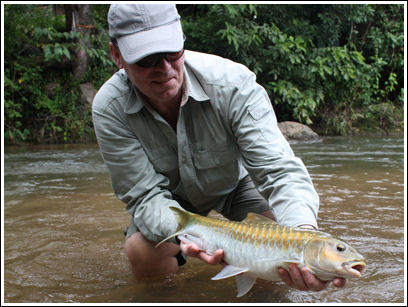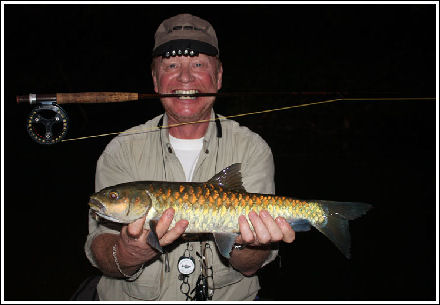|
Mahseer
Species
By Jonas Nyqvist
Mahseer is the
common name used for the genera Tor, Neolissochilus, and
Naziritor in the family Cyprinidae (carps).The name Mahseer
is however more often restricted to members of the genus
Tor. The taxonomy of the Mahseer is confusing due to the
morphological variations they exhibit. In developing
strategies for aquaculture and propagation assisted
rehabilitation of Mahseer species, there is a need to
resolve taxonomic ambiguities.
Mahseer inhabit both
rivers and lakes, ascending to rapid streams with rocky
bottoms for breeding. Like other types of carps, they are
omnivorous, eating not only algae, crustaceans, insects,
frogs, and other fish, but also fruits that fall from trees
overhead. The first species from this group were
scientifically described by Francis Buchanan-Hamilton in
1822, and first mentioned as an angling challenge by the
Oriental Sporting Magazine in 1833, soon becoming a favorite
quarry of British anglers living in India.
The Hindi name of
mahāsir, mahāser, or mahāsaulā is used for a number of
fishes of the group. British anglers in India called them
the Indian salmon. Several sources of the common name
Mahseer have been suggested: It has been said to be derived
from Sanskrit, while others claim it is derived from
Indo-Persian, Mahi- fish and Sher- tiger or tiger among fish
in Persian, alternatively, mahā-śalka, meaning large-scaled,
as the scales are so large that Buchanan mentions that
playing cards were made from them at Dacca. Another theory
by Henry Sullivan Thomas suggests mahā-āsya; great mouth.
The name Mahasher is commonly used in Urdu, Punjabi and
Kashmiri languages in Pakistan for this fish and is said to
be made up of two local words: Maha = big and sher = lion as
it ascends in the hilly rivers and streams of Himalaya
courageously.
There are 14 major Mahseer
species under the Tor Genus and two under the Neolissochilus
Genus:
Humpback Mahseer -
Hypselobarbus mussullah (also called Tor mussullah)
Semah Mahseer - Tor douronensis
Thai Mahseer - Tor Tambroide
Deccan Mahseer - Tor khudree
Malabar mahseer - Tor khudree malabaricus
Golden Mahseer - Tor putitora
Soro Mahseer - Tor tambra
Chinese Mahseer or Mekong Red Mahseer - Tor sinensis
Dark Mahseer - Tor chelynoides
Blue Mahseer - Tor Neilli
Redfin Mahseer - Tor tor
Mosal Mahseer or Copper Mahseer - Tor mosal
Jungha Mahseer - Tor progenius
Zhobi mahseer - Tor zhobensis (also called Naziritor
zhobensis
Chocolate mahseer (also called Copper Mahseer) -
Neolissochilus hexagonolepis
Stracheyi Mahseer - Neolissochilus stracheyi (also called
Tor stracheyi)
(There are more species in
the Tor and Neolissochilus Genus but most of them are very
small species and not of any interest for the fly
fisherman.)
The most interesting
Mahseer species for fly the fisherman are the following
ones:

Thai Mahseer - Tor Tambroides
Thai Mahseer is
found in clear, clean rivers in the mountains. Reported
from: Chao Phraya and Mekong basins, Malay Peninsula,
Sumatra, Java, and Borneo, Myanmar (Burma), Salween and Mae
Klong rivers. Habitat: Medium to large rivers with rocky,
sandy and leafy bottom. Prefers highly oxygenated water and
dark environment. Adults inhabit pools and runs over gravel
and cobble in rivers flowing through undisturbed forests.
Juveniles were most commonly collected in or near rapids.
Found in small rivers and streams during the dry season.
Move downstream at the onset of the rainy season, but
generally avoid turbid waters. Mature individuals migrate
upstream after two months and spawn in July near the mouths
of small streams that the young subsequently ascend. Habits:
Stations itself in prime lies where its needs of security,
shelter and food it readily served. May forage in shallow
areas or close to rapids when it is assured of security. A
very shy fish. Omnivorous, feeding on both animal and
vegetable matter, at times consuming toxic fruits in flooded
forests, making them temporarily inedible. Max size is about
100 cm and 27 kg. Scientific research in Malaysia has proved
that a 3 kg size Thai Mahseer is approximate 8 years old and
a 8-9 kg fish around 30 year old, so it's very important to
release the big fish. Common English names for the Thai
Mahseer are: Greater Brook Carp and Malaysian Red Mahseer.
Common local names are: Pla Wien (Thailand), Kelah
(Peninsular Malaysia), Empurau/Semah (Sarawak), Pelian
(Sabah). Recommended fly equipment for Thai Mahseer: class
5-7 9ft. rods, Large arbor reels with very good brake system
holding min 150 meters of 30 lb backing, floating lines,
12-20 lb nylon or fluorocarbon leaders, small streamer
flies, popper flies, wet flies, nymphs and large dry flies.
Visit
www.fly-fishing-in-thailand.com or e-mail me at:
typhoontackle(at)yahoo.com for Thai Mahseer fly fishing trips
in Thailand and Burma.

Stracheyi Mahseer -
Neolissochilus stracheyi
(also called Tor stracheyi)
Stracheyi Mahseer is
found in clear, clean rivers in the mountains of Myanmar
through Thailand and possibly to the Cardamon Range,
Cambodia. Known from Salween, Maeklong, Chao Phraya, Mekong
and Peninsular and Southeast Thailand river systems. They
inhabit clear, swift-flowing forested streams and rivers.
Disappears when human activities degrade aquatic habitats,
as seen in other members of the genus. Has 9 branched
dorsal-fin rays; presence of black lateral stripe smooth and
non-osseous last simple dorsal ray; large patch of tubercles
on side of snout and below eye; post-labial groove
interrupted medially; color in life bronze back and silvery
belly Habits: Stations itself in prime lies where its needs
of security, shelter and food it readily served. May forage
in shallow areas or close to rapids when it is assured of
security. A very shy fish. Omnivorous, feeding on both
animal and vegetable matter, at times consuming toxic fruits
in flooded forests, making them temporarily inedible. Max
size is about 80 cm and 10 kg. Common local names are: Pla
Peang (Thailand), Recommended fly equipment for Stracheyi
Mahseer: class 5-6 9ft. rods, Large arbor reels with very
good brake system holding min 100 meters of 30 lb backing,
floating lines, 10-16 lb nylon or fluorocarbon leaders,
small streamer flies, popper flies, wet flies, nymphs and
large dry flies. Visit
www.fly-fishing-in-thailand.com or
e-mail me at: typhoontackle(at)yahoo.com for Stracheyi Mahseer
fly fishing trips in Thailand and Burma.

Golden Mahseer - Tor
putitora
Inhabit streams,
riverine pools and lakes. Found in rapid streams with rocky
bottom. Omnivorous, feeding on fish, zooplankton, dipteran
larvae and plant matter. Juveniles subsist on plankton while
fingerlings feed mainly on algae. Ascend streams to breed
over gravel and stones and returns to perennial ponds after
breeding. The Golden Mahseer is a very attractive sport
fish, with excellent food value. Threatened due to over
harvesting and habitat loss in many areas. Found from:
Afghanistan, Pakistan, India, Nepal, Bangladesh, Bhutan,
Kachin state in northern Burma to the Salween river system
in eastern Burma and its tributaries in Mae Hong Son
Province, Thailand. Max. Published weight: 54.0 kg but fish
over 80 kg have been caught in the Himalayas and
http://fishbase.org reports of fish up to 275cm long! During
the spawning run the Golden Mahseer can swim against full
blown out rivers in the Himalayas in 20 knot speed! Summary
of an Indian caught Golden Mahseer showed the stomach
contained: 81,7% insects and larvae, 2,4% fish remains
(finfish, bony fish) and 15,9% plant debris. Recommended fly
equipment for Golden Mahseer: rods: class 7-10 single hand
or switch rods, fly reels with very good drag system and
capacity for 300 meters of 30-40 lb backing, floating,
intermediate and sinking lines, depending on the river
condition, 20-30 lb fluorocarbon or nylon leaders, streamer
flies, wet flies, big nymphs and large dry flies.

Visit
http://www.flyfishbhutan.net and contact e-mail Bryant
Dunn for Golden Mahseer fly fishing trips in Bhutan. For fly
fishing trips in India for Golden Mahseer contact Misty
Dhillon at:
www.himalayanoutback.com

Many of the other
Mahseer species listed above will take flies, we have
explored some rivers in Laos for Tor sinensis (also called
Chinese Mahseer or Mekong red Mahseer) and for Tor Barb
(also called Redfin Mahseer) - Tor tor, but most of the
rivers were poached and fished out and did not offer any
good action, longer expeditions far into the jungle is
needed in Laos to find the pristine rivers with healthy
Mahseer stocks.
Burma, Nepal and
India can become future Mahseer fly fishing destinations for
some of the other Mahseer species listed above, time will
tell. The Chocolate Mahseer (Neolissochilus hexagonolepis)
and the Mosal Mahseer or Copper Mahseer (Tor mosal) are
available in large numbers in some of the rivers in Nepal,
Bhutan, Kachin state in Burma and in Arunachal Pradesh state
in NE India. These two Mahseer species have been caught on
fly and grows to a respectable size.

By Jonas
Nyqvist 2012
Visit Jonas blog:
http://mahseer-fly-fishing.blogspot.se
|